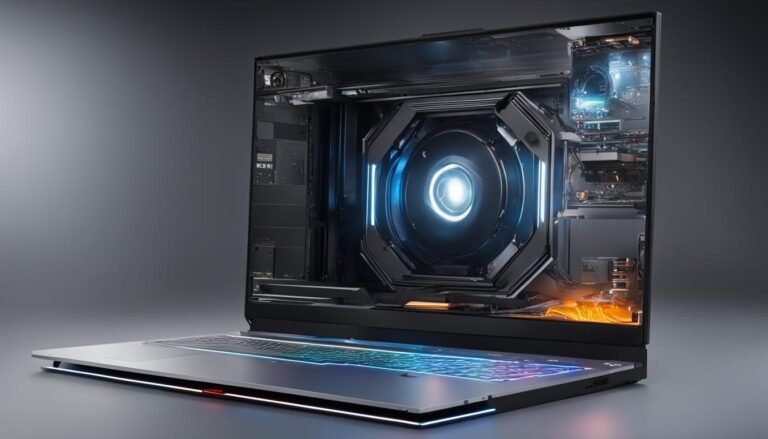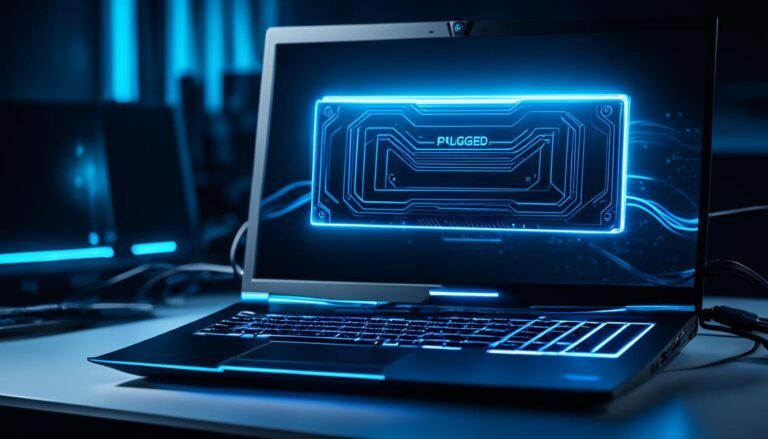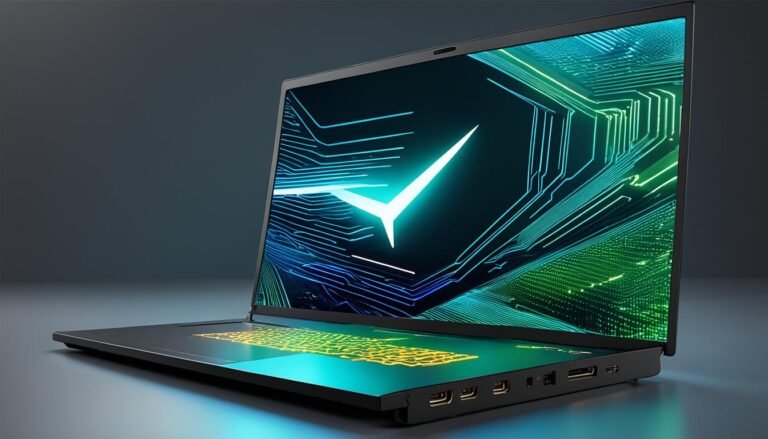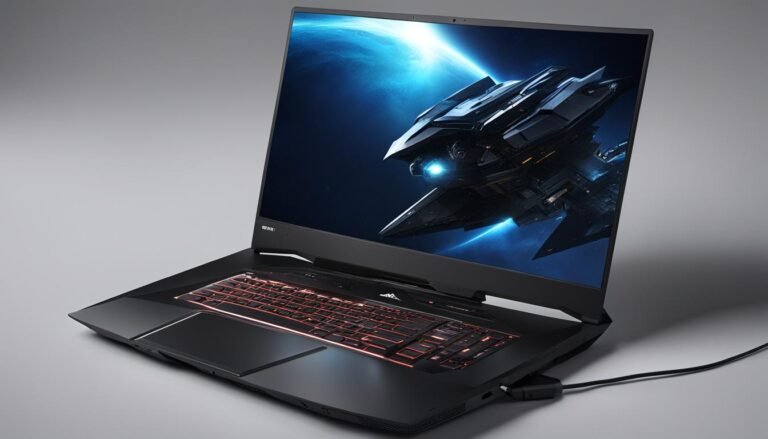Unlock Graphics Power: Best External GPU Guide
If you’ve ever desired for your laptop’s graphics performance to be better, then an external GPU power supply could be the solution. An external GPU power supply connects a desktop-class graphics card to a laptop or compact computer via Thunderbolt 3, significantly enhancing graphics performance for systems with integrated or weaker dedicated GPUs.
Key Takeaways:
- An external GPU power supply can boost graphics performance of laptops and compact computers.
- It connects a desktop-class graphics card to the system via Thunderbolt 3.
- It is ideal for systems with integrated or weaker dedicated GPUs.
- eGPUs are suitable for gaming, 3D rendering, and other graphics-intensive tasks.
- They provide a cost-effective solution compared to buying a new computer.
Understanding External GPU Power Supply
An external GPU power supply plays a vital role in providing a separate power source for high-performance graphics cards in laptops or computers that lack internal power supply and space. This setup typically consists of a housing for the graphics card, a power supply unit (PSU), and a connection port such as Thunderbolt 3. By utilizing an external GPU power supply, users can experience enhanced graphics performance, making it suitable for gaming, 3D rendering, and other resource-intensive tasks.
External GPUs, also known as eGPUs, are becoming increasingly popular among laptop users who require additional graphics power. The ability to connect a desktop-class graphics card to a portable device allows for a significant boost in performance, bridging the gap between laptops with integrated or weaker dedicated GPUs and full-fledged desktop computers.
With an external GPU for a laptop, users can enjoy smooth gameplay, improved visual quality, and faster rendering times. The external graphics dock provides the necessary power and performance to run demanding games and graphics-intensive applications on laptops that would otherwise struggle to meet the requirements.
“The combination of an external graphics card and a laptop opens up a world of possibilities for gaming enthusiasts and professionals seeking enhanced graphics performance on the go.”
Contracting the image below, you can see how the external GPU power supply connects to a laptop:
| Benefits of External GPU Power Supply |
|---|
| 1. Improved graphics performance for laptops with weaker dedicated GPUs or integrated graphics. |
| 2. Ability to run demanding games and resource-intensive applications on laptops. |
| 3. Enhanced visual quality and smoother gameplay experience. |
| 4. Faster rendering times for 3D designers and video editors. |
Compatibility and Setup of External GPU
Before investing in an external GPU setup, it’s crucial to ensure compatibility between the eGPU enclosure, the graphics card, and the laptop or computer. The most common connection port for eGPU installations is Thunderbolt 3, although newer connections like Thunderbolt 4 or USB4 can also be compatible. However, it’s essential to check the specifications and compatibility of the laptop or PC with the chosen eGPU interface.
Setting up an external GPU involves attaching the enclosure to the laptop or computer, connecting the external power supply, and installing the necessary GPU drivers. Some systems may require additional setup procedures or BIOS settings to enable eGPU capabilities. It’s advisable to follow the manufacturer’s instructions and guidelines for a seamless setup process.
With the external GPU power supply properly connected and configured, users can harness the full potential of their laptop or compact computer by unleashing the true power of high-performance graphics cards.
Compatibility and Setup of eGPU Power Supplies
When considering an external GPU setup, it is crucial to understand the compatibility requirements and the setup process. The successful installation and operation of an eGPU enclosure depend on the connection type and the compatibility with your laptop or PC.
The most popular interface for eGPU installations is Thunderbolt 3, which provides high-speed data transfer and power delivery. However, newer connections like Thunderbolt 4 or USB4 can also work, offering potential compatibility and performance benefits.
Before purchasing an external GPU enclosure, ensure that your laptop or PC supports the specified interface. This compatibility check is important to ensure seamless integration and optimal performance.
Setup Process
- Attach the eGPU enclosure to your laptop or computer. The enclosure typically comes with a Thunderbolt or USB connection port for easy connectivity.
- Connect the external power source to the eGPU enclosure. The power supply provides the necessary energy for the high-performance graphics card.
- Install the required GPU drivers for the eGPU. These drivers enable the system to recognize and utilize the external graphics card effectively.
- Depending on the computer, additional setup procedures or BIOS settings may be necessary to enable eGPU capabilities and ensure smooth operation.
Once the setup is complete, your laptop or PC will be ready to harness the power of the external GPU enclosure, enhancing graphics performance for gaming, content creation, and other resource-intensive tasks.
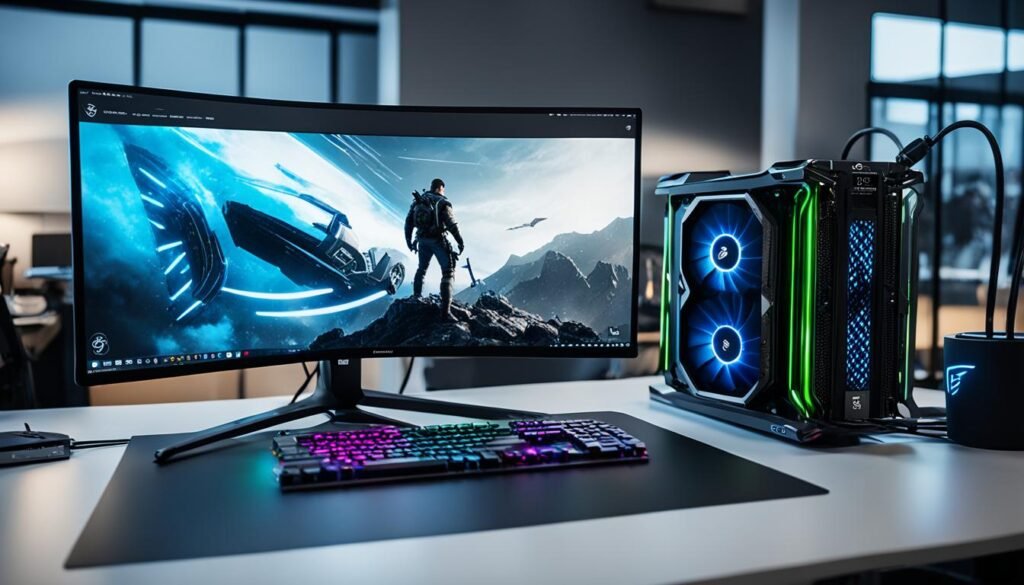
| eGPU Interface | Compatibility |
|---|---|
| Thunderbolt 3 | Wide compatibility with many laptops and PCs |
| Thunderbolt 4 | Improved compatibility and potential performance benefits |
| USB4 | Emerging interface with compatibility potential |
Performance and Portability of eGPUs
An eGPU, or external graphics processing unit, can significantly enhance the graphics performance of a laptop or compact computer, making it suitable for demanding tasks such as gaming, 3D rendering, and video editing. While it may not provide the same level of performance as a dedicated desktop PC, eGPUs offer a convenient and portable solution for users who require a boost in graphics capabilities.
When it comes to eGPU performance, it’s important to consider both the graphics card itself and the limitations imposed by the external connection. While the addition of an eGPU can undoubtedly improve graphics performance, the magnitude of this improvement may vary depending on factors such as the specific eGPU enclosure, the chosen graphics card, and the tasks performed.
One of the key advantages of eGPUs is their portability. With an eGPU setup, users can utilize the same graphics card across different laptops or computers, providing flexibility and convenience in terms of hardware usage. This portability also allows for easier sharing of the eGPU setup among multiple devices or even among different users.
In summary, eGPUs offer a significant performance boost for graphics-intensive tasks, such as gaming, rendering, and video editing. While the performance may not match that of a dedicated desktop PC, the portability of eGPUs makes them a versatile solution for users who require enhanced graphics capabilities across multiple devices.
Cost and Affordability of eGPUs
When considering an external GPU setup, the cost factor is a significant consideration to keep in mind. While the benefits of improved graphics performance are undeniable, it’s essential to evaluate the affordability of investing in an eGPU enclosure.
The cost of an eGPU enclosure can be relatively high, particularly when factoring in the additional expense of a compatible GPU. In many cases, the overall cost can parallel that of building a midrange desktop computer. However, it’s important to assess the long-term benefits and cost-effectiveness of the eGPU setup.
One advantage of external GPUs is the ability to upgrade the eGPU itself instead of purchasing an entirely new computer. This flexibility can potentially save costs in the long run, as graphics advancements continue to emerge. By upgrading the GPU alone, you can keep up with the latest graphics capabilities without the need to invest in an entirely new system.
Investing in an eGPU setup may require a significant upfront cost, but the ability to upgrade the eGPU instead of buying a new computer can be a cost-effective approach in the long term.
When weighing the cost and affordability of external GPUs, it’s crucial to consider your specific needs and usage requirements. Evaluate the potential performance gains and compare them to the investment required.
Cost Comparison of eGPU Enclosures
| eGPU Enclosure Model | Price Range | Notable Features |
|---|---|---|
| Razer Core X | $299 – $399 | Easy setup, additional USB ports |
| Akitio Node Pro | $349 – $399 | Balance between power and portability |
| ASUS ROG XG Station Pro | $399 – $499 | Stylish design, fast internet connectivity |
| Sonnet eGFX Breakaway Box | $229 – $299 | Simple and compact design |
Software and Driver Support for eGPUs
eGPU support relies heavily on the applications and operating system being used. While Windows generally offers robust support for eGPUs, support for macOS has seen improvements but remains limited. Meanwhile, support for Linux can vary depending on compatibility and available drivers. When setting up an eGPU, it is crucial to ensure that both the software and drivers are compatible with your chosen eGPU configuration to ensure optimal performance and functionality.
Operating System Support for eGPUs
When it comes to eGPUs, the level of software and driver support can greatly impact the user experience. Let’s take a closer look at the operating system specifics:
Windows: As the most prevalent operating system in the gaming world, Windows offers robust support for eGPUs. The presence of well-established driver frameworks, such as NVIDIA’s GeForce Experience and AMD’s Adrenalin, ensures smooth integration and easy setup for eGPU users.
macOS: Apple has made strides in improving eGPU support in recent years, particularly with the introduction of macOS High Sierra. Although support has advanced, there are still some limitations. For example, eGPUs are not compatible with all Mac models, and certain applications may not fully utilize the eGPU’s capabilities. However, macOS Monterey introduces additional features and enhancements to eGPU support, providing a promising outlook for Mac users.
Linux: Linux support for eGPUs can vary depending on the specific distribution and hardware. Some distributions offer more comprehensive support and user-friendly installation processes, while others may require manual setup and driver configuration. Communities such as the eGPU.io forum can provide valuable resources and guidance for Linux eGPU enthusiasts.
Application Compatibility
In addition to the operating system, the compatibility of eGPUs with various applications can also impact their usability. While most applications can benefit from the enhanced graphics processing power provided by eGPUs, not all software is optimized to take full advantage of them. It is crucial to verify the compatibility of your preferred applications and consider any necessary updates or configurations to maximize the benefits of your eGPU setup.
Driver Updates and Optimization
Regularly updating your eGPU drivers is essential for maintaining software compatibility and performance. Both AMD and NVIDIA frequently release driver updates that introduce bug fixes, optimizations, and enhanced functionality. These updates can address compatibility issues with specific applications and may even offer performance improvements for eGPU users. Staying up to date with the latest driver versions ensures the best possible experience with your eGPU.
Optimizing your eGPU software settings is another critical aspect to consider. Some eGPU enclosures come with accompanying software that allows you to fine-tune settings, monitor performance, and adjust fan speeds. Additionally, software tools such as Radeon Software by AMD and NVIDIA Control Panel provide additional customization options to maximize performance and establish a tailored experience.
Below is a table summarizing eGPU software and driver support across different operating systems:
| Operating System | Software Support | Driver Support |
|---|---|---|
| Windows | Strong support with dedicated management software available from GPU manufacturers (e.g., GeForce Experience, Adrenalin) | Frequent driver updates with comprehensive support |
| macOS | Improved support with macOS High Sierra and macOS Monterey | Driver updates released by Apple and GPU manufacturers, with some limitations |
| Linux | Varies depending on the specific distribution and hardware | Varied support, community-driven updates and configurations |

Ensuring proper software and driver compatibility is essential when setting up an eGPU. By understanding the level of support provided by different operating systems and verifying the compatibility of your preferred applications, you can optimize your eGPU configuration for optimal performance and functionality.
Benefits of Using an eGPU
Using an eGPU can provide a range of benefits that enhance your gaming experience and overall system performance. Whether you’re a gamer, 3D designer, or video editor, incorporating an eGPU into your setup can greatly improve graphics performance and create a smoother computing experience.
One of the primary benefits of using an eGPU is the significant boost in graphics performance. By connecting a high-performance graphics card to your laptop or compact computer, you can enjoy enhanced visuals, sharper details, and faster frame rates. This means more immersive gaming experiences, smoother 3D rendering, and quicker video editing.
An eGPU can also reduce lag and latency, resulting in a more responsive and seamless gaming experience. The added graphics power allows your system to handle demanding tasks without slowdowns or performance issues. This is especially beneficial for competitive gaming, where split-second reactions can make a significant difference.
In addition to improved graphics performance, an eGPU can boost your overall system performance. By offloading graphics-intensive tasks to the external GPU, your CPU and RAM can focus on other processes, leading to smoother multitasking and faster render times. This can greatly enhance productivity for tasks such as video editing, 3D modeling, and simulations.
Portability is another advantage of using an eGPU. With a single graphics card and enclosure, you can easily connect it to different laptops or computers, eliminating the need to invest in multiple high-end systems. This flexibility allows you to take your enhanced graphics performance with you wherever you go, whether it’s for work, gaming tournaments, or creative projects.
Overall, the benefits of using an eGPU are undeniable. From improved graphics performance and reduced lag to boosted system performance and portable convenience, incorporating an eGPU into your setup can revolutionize your gaming and computing experience. With the investment in an eGPU, you can achieve enhanced visuals and productivity without the need to purchase an entirely new computer system.
Popular eGPU Power Supply Models
When it comes to choosing an eGPU power supply, there are several popular models available on the market. Each of these models offers unique features and capabilities for enhancing your graphics performance. Let’s take a closer look at some of the top eGPU power supply options:
Razer Core X
The Razer Core X is widely recognized for its easy setup process and convenient extra USB ports. This power supply model allows for seamless integration with your laptop or compact computer, providing a significant boost to your graphics capabilities. With the Razer Core X, you can enjoy enhanced gaming experiences and smoother graphics rendering.
Akitio Node Pro
The Akitio Node Pro strikes a perfect balance between power and portability. This eGPU power supply offers ample performance to handle demanding graphics tasks while maintaining a compact and lightweight design. Whether you’re a gamer or a professional working in the creative field, the Akitio Node Pro is an excellent choice.
ASUS ROG XG Station Pro
For those seeking a sleek and stylish eGPU power supply, the ASUS ROG XG Station Pro is an ideal option. This power supply not only boosts your graphics performance but also adds a touch of elegance to your setup. Moreover, it comes with additional features such as fast internet connectivity, ensuring a seamless gaming or creative experience.
Sonnet eGFX Breakaway Box
The Sonnet eGFX Breakaway Box is a simple and compact power supply model. While it may not have extra features, it provides reliable performance and compatibility for your eGPU setup. If you’re looking for a straightforward and efficient power supply option, the Sonnet eGFX Breakaway Box is worth considering.
These are just a few examples of the popular eGPU power supply models available in the market. Each model offers unique features to enhance your graphics performance. Consider your specific needs and preferences when selecting the right eGPU power supply for your setup.
Best eGPUs for Gaming
When it comes to gaming with an external GPU setup, there are several top-performing options available in the market. These eGPUs offer impressive graphics performance, allowing gamers to enjoy smooth gameplay and immersive visuals. Let’s explore some of the best eGPUs for gaming:
1. AMD Radeon RX 7600
The AMD Radeon RX 7600 is a budget-friendly eGPU that delivers solid 1080p gaming performance. It offers excellent value for money with its affordable price tag and is capable of running modern games with ease. With its powerful GPU architecture and advanced features, the RX 7600 ensures a smooth gaming experience without breaking the bank.
2. Nvidia RTX 4060
For Nvidia enthusiasts, the Nvidia RTX 4060 is a fantastic choice. This eGPU combines outstanding efficiency with support for DLSS upscaling technology. The RTX 4060 delivers impressive graphics performance, allowing gamers to enjoy high-quality visuals and smooth gameplay. It is a reliable option for those looking for a powerful eGPU solution.
3. AMD RX 6750 XT
The AMD RX 6750 XT is a high-performance eGPU suitable for 1440p gaming. It offers a reasonable price point while delivering exceptional graphics capabilities. With its powerful GPU and advanced features, the RX 6750 XT provides a smooth gaming experience with stunning visuals. Gamers can enjoy their favorite titles at higher resolutions without compromising performance.
4. Nvidia RTX 4070 Ti
If you’re looking for top-of-the-line performance, the Nvidia RTX 4070 Ti is an excellent choice. This high-end eGPU offers superior graphics performance, thanks to its DLSS and CUDA core support. The RTX 4070 Ti delivers exceptional power for both gaming and content creation, making it perfect for demanding tasks that require maximum GPU performance.
5. AMD RX 7800 XT
The AMD RX 7800 XT is a powerhouse eGPU that excels in both 1440p and 4K gaming. With its robust GPU architecture and advanced features, the RX 7800 XT offers incredible graphics performance and immersive visuals. Gamers can enjoy high-resolution gaming with smooth frame rates, unlocking the full potential of their gaming experience.
Having one of these eGPUs in your gaming setup can take your gaming experience to the next level. Whether you’re on a budget or seeking high-end performance, there is an eGPU option to suit your needs. Choose the eGPU that aligns with your gaming preferences and start enjoying enhanced graphics performance today!
How to Undervolt Your GPU for Enhanced Performance
Undervolting your GPU is a technique that can significantly improve performance and reduce power consumption. By adjusting the voltage settings, you can find the optimal balance between stability and power efficiency, maximizing the capabilities of your graphics card.
To undervolt your GPU, you can use software programs like MSI Afterburner or Radeon WattMan. These tools allow you to modify the voltage and frequency settings of your GPU, fine-tuning its performance according to your needs.
It’s important to note that undervolting is not a one-size-fits-all solution. Different GPUs have varying voltage requirements, and the optimal undervolt settings may vary depending on your specific hardware configuration.
When undervolting your GPU, it’s crucial to test and monitor the stability of the settings. Gradually adjust the voltage and observe how it affects the performance and stability of your system. This way, you can find the optimal undervolt settings that provide a balance between improved performance and stability.
Undervolting your GPU has several benefits:
- Improved Performance: By finding the optimal voltage settings, you can boost the performance of your GPU, allowing for smoother gameplay and faster graphics rendering.
- Reduced Power Consumption: Undervolting can lower the power requirements of your GPU, resulting in reduced energy consumption and potentially lower temperatures.
- Increased Lifespan: By reducing the operating voltage, you can potentially extend the lifespan of your GPU by minimizing stress and heat generation.
Undervolting your GPU requires careful experimentation and monitoring, as optimal settings may vary from one system to another. It’s recommended to consult community forums and resources dedicated to GPU optimization to learn from the experiences of other users and find the best undervolt settings for your specific graphics card.
| Benefits of Undervolting Your GPU |
|---|
| Improved Performance |
| Reduced Power Consumption |
| Increased Lifespan |
Optimizing Your eGPU Setup for Best Results
When it comes to maximizing the performance of your eGPU setup, there are several important factors to consider. By optimizing cooling, regularly updating drivers, and fine-tuning software settings, you can achieve the best graphics performance for your needs.
1. Cooling
Proper cooling is essential for maintaining optimal performance and preventing overheating in your eGPU enclosure. Ensure that there is adequate airflow within the enclosure by placing it in a well-ventilated area. Additionally, consider using additional cooling solutions such as fans or liquid cooling systems to regulate the temperature of the graphics card.
2. Driver Updates
Regularly updating your GPU drivers is crucial for ensuring compatibility and taking advantage of the latest optimizations. Check for driver updates from the manufacturer’s website or use automatic driver update utilities. By keeping your drivers up to date, you can enhance performance, stability, and potentially resolve any compatibility issues.
3. Software Settings
Optimizing software settings specific to your applications can significantly improve graphics performance. Explore the settings within your applications and graphics card control panel to fine-tune options such as anti-aliasing, texture filtering, or resolution scaling. Adjusting these settings based on your preferences and system capabilities can result in smoother gameplay and better visual quality.
4. Experimentation
Don’t be afraid to experiment with different settings and configurations to find the optimal setup for your eGPU. Each system and application may have unique requirements, so it’s essential to test and compare different settings to identify the most suitable configuration for your needs. Keep notes of the changes you make and their impact to help guide your optimization journey.
By considering these factors and optimizing your eGPU setup, you can unlock the full potential of your external graphics card. Enhancing cooling, updating drivers, and tweaking software settings are key to achieving the best results in terms of graphics performance and overall system stability.
| Optimization Factor | Benefits |
|---|---|
| Cooling | – Improved GPU performance – Prevents overheating |
| Driver Updates | – Enhanced compatibility – Improved stability |
| Software Settings | – Better visual quality – Smoother gameplay |
| Experimentation | – Customized optimization – Fine-tuned performance |
Conclusion
Unlocking the full graphics power of your laptop or compact computer is possible with the addition of an external GPU power supply. By following the steps outlined in this guide and considering the various factors involved, you can create an optimal eGPU setup that enhances your computing experience.
With the right eGPU enclosure and graphics card, you’ll enjoy improved gaming performance, smoother graphics, and increased productivity for tasks such as 3D rendering and video editing. The external GPU power supply unleashes the true potential of your system, bridging the gap between integrated or weaker dedicated GPUs and desktop-class graphics cards.
Take into account the compatibility, setup process, performance, and portability of eGPU power supplies. Consider the cost-effectiveness and long-term benefits as you invest in an external GPU setup, weighing it against the alternatives of building a midrange desktop computer or purchasing a new system.
Maximize the benefits of using an eGPU by ensuring software and driver support, optimizing your setup for the best results, and exploring popular eGPU power supply models. By integrating an external GPU into your computing setup, you can unlock the graphics power needed to elevate your gaming, design, and multimedia experiences to new heights.
FAQ
What is an external GPU power supply?
An external GPU power supply connects a desktop-class graphics card to a laptop or compact computer via Thunderbolt 3, significantly enhancing graphics performance for systems with integrated or weaker dedicated GPUs.
What is the main function of an eGPU power supply?
The main function of an eGPU power supply is to give a high-performance graphics card a separate power source for laptops or computers lacking the required internal power supply and space. It improves graphics performance and is suitable for gaming, 3D rendering, and more.
What is the compatibility and setup process for eGPU enclosures?
The compatibility of an eGPU enclosure depends on the connection type and the laptop or PC being used. The most popular interface is Thunderbolt 3, but Thunderbolt 4 or USB4 can also work. The setup process involves attaching the enclosure to the laptop or computer, connecting the external power source, and setting up the required GPU drivers.
How does an eGPU affect performance and portability?
An eGPU can greatly enhance graphics performance, making it suitable for gaming, 3D rendering, and video editing. However, the performance boost may not be as significant as with a dedicated desktop PC due to the limitations of the external connection. One of the advantages of eGPU systems is their portability, allowing the same GPU to be used with different laptops or computers.
What is the cost and affordability of eGPUs?
The cost of an eGPU enclosure can be expensive, especially when considering the additional cost of a compatible GPU. The overall cost may be comparable to building a midrange desktop computer. However, this cost can be justified by the improved graphics performance and the ability to upgrade the eGPU instead of buying a new computer.
What is the software and driver support for eGPUs?
eGPU support varies depending on the applications and operating system. Windows generally has stronger support, while support for macOS has improved but is still limited. Support for Linux can also vary. It is important to ensure that the software and drivers are compatible with the chosen eGPU setup for optimal performance and functionality.
What are the benefits of using an eGPU?
Using an eGPU provides benefits such as improved graphics performance, reduced lag, boosted overall system performance, and portability. It allows for a smoother gaming and graphic experience, making it ideal for gamers, 3D designers, and video editors. Additionally, it can be a cost-effective solution compared to buying a new computer with better graphics capabilities.
What are some popular eGPU power supply models?
Some popular eGPU power supply models include the Razer Core X, Akitio Node Pro, ASUS ROG XG Station Pro, and Sonnet eGFX Breakaway Box. Each model offers different features and options to suit various needs.
What are the best eGPUs for gaming?
Some of the best eGPUs for gaming include the AMD Radeon RX 7600, Nvidia RTX 4060, AMD RX 6750 XT, Nvidia RTX 4070 Ti, and AMD RX 7800 XT. These models offer different levels of performance and support for various gaming resolutions.
How can I undervolt my GPU for enhanced performance?
Undervolting your GPU can help improve performance and reduce power consumption. This process involves adjusting the voltage to find the optimal balance between stability and power efficiency. Software programs such as MSI Afterburner or Radeon WattMan can be used to modify the voltage and frequency settings of the GPU.
How can I optimize my eGPU setup for the best results?
To optimize your eGPU setup, consider factors such as cooling, driver updates, and software settings. Proper airflow and temperature management within the enclosure can help improve performance and prevent overheating. Regularly updating GPU drivers and optimizing software settings for specific applications can also result in better graphics performance. Experimenting with different settings and configurations can help fine-tune your eGPU setup for the best results.
How does adding an external GPU power supply unlock graphics power?
Adding an external GPU power supply to your laptop or compact computer unlocks the full graphics power potential and enhances your computing experience. With the right eGPU enclosure and graphics card, you can enjoy improved gaming performance, smoother graphics, and increased productivity for tasks such as 3D rendering and video editing.

